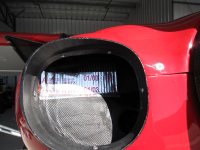Tankerpilot75
Well Known Member
My engine was torn down and rebuilt with dual PMags replacing Slick mags following a prop strike at last year’s AirVenture by Popular Grove with Myers Aviation handling the removal and reinstall plus some other work. Had cylinder heads IRAN during rebuild with new guides installed. Picked aircraft up in late March and flew it home. Ran great with all CHT temperatures below 400 degrees.
CHT #3 is now having a hard time staying below 400 degrees in cruise. The engine has 20 hours since rebuild. Wish it was more but other issues got in the way of flying.
I’ve basically been flying at 24”, 2400 rpm and 12 gph at cruise since leaving OSH last March (break-in recommendation). Did my initial oil change at 12 hours post rebuild. Had a PMag problem with rpm dropping 200 rpm when doing mag checks at around 12 hours. EMag replaced the bearing on one PMag which corrected the issue. Infant mortality - it happens!
I also had to rewire my CHT/EGT sensor wires to the EIS because, for some reason, they didn’t align with their correct cylinders (1=2, 2=1, 3=4, 4=3). I think it had been wired this way since before I bought it eight years ago by the builder. It took the CHT issue to highlight this discovery with identifying and correcting the problem taking lots of time and patience. Anyway, CHT and EGT readings now align correctly but CHT #3 is running high and it appears to not be going away after 20 hours of break-in run time.
#3 CHT is at least 25-30 degrees higher than #4 CHT and 35-40 degrees higher than #1 and #2. I’ve looked at baffling and even put a washer between #3 cylinder and the rear baffle wall. That helped a little but not enough.
At 2400 rpm, 24” and 12 gph fuel flow (break-in settings) CHT#3 will run about 410-420 degrees CHT in these hot summer temperatures. Takeoff and climb are not a problem because of my higher climb out speed (110 kts) and full rich fuel flow (~14.4 gph).
So I’ve been generally at 24”, 2400 rpm and 12 gph for these last 20 hours. If I throttle back to 2300 rpm, 23” it’ll drop back to around 390-400 degrees. If I try to lean to -100 ROP (around 9.8 to 10.2 gph) the #3 CHT will climb to 420 and higher. Other cylinders generally stay between 360 - 390 at all fuel flow settings during cruise. It was suggested I not run LOP until at least 25 hours. With CHT#3 still wanting a very rich fuel flow for cooling I dare not run LOP.
I would think all cylinders would be broken in by now. Oil consumption is stable. What do you think is going on? Any ideas?
CHT #3 is now having a hard time staying below 400 degrees in cruise. The engine has 20 hours since rebuild. Wish it was more but other issues got in the way of flying.
I’ve basically been flying at 24”, 2400 rpm and 12 gph at cruise since leaving OSH last March (break-in recommendation). Did my initial oil change at 12 hours post rebuild. Had a PMag problem with rpm dropping 200 rpm when doing mag checks at around 12 hours. EMag replaced the bearing on one PMag which corrected the issue. Infant mortality - it happens!
I also had to rewire my CHT/EGT sensor wires to the EIS because, for some reason, they didn’t align with their correct cylinders (1=2, 2=1, 3=4, 4=3). I think it had been wired this way since before I bought it eight years ago by the builder. It took the CHT issue to highlight this discovery with identifying and correcting the problem taking lots of time and patience. Anyway, CHT and EGT readings now align correctly but CHT #3 is running high and it appears to not be going away after 20 hours of break-in run time.
#3 CHT is at least 25-30 degrees higher than #4 CHT and 35-40 degrees higher than #1 and #2. I’ve looked at baffling and even put a washer between #3 cylinder and the rear baffle wall. That helped a little but not enough.
At 2400 rpm, 24” and 12 gph fuel flow (break-in settings) CHT#3 will run about 410-420 degrees CHT in these hot summer temperatures. Takeoff and climb are not a problem because of my higher climb out speed (110 kts) and full rich fuel flow (~14.4 gph).
So I’ve been generally at 24”, 2400 rpm and 12 gph for these last 20 hours. If I throttle back to 2300 rpm, 23” it’ll drop back to around 390-400 degrees. If I try to lean to -100 ROP (around 9.8 to 10.2 gph) the #3 CHT will climb to 420 and higher. Other cylinders generally stay between 360 - 390 at all fuel flow settings during cruise. It was suggested I not run LOP until at least 25 hours. With CHT#3 still wanting a very rich fuel flow for cooling I dare not run LOP.
I would think all cylinders would be broken in by now. Oil consumption is stable. What do you think is going on? Any ideas?






